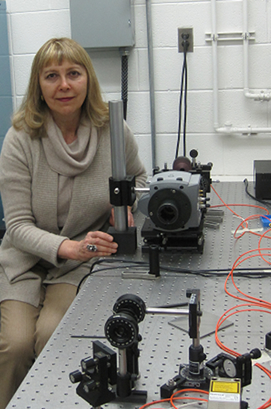Dr. Svetlana Lukishova

Svetlana G. Lukishova was born in Moscow. Her research career began at the P.N. Lebedev Physical Institute (Russian Acad. of Sciences, Moscow) where she carried out her Bachelor, Master and Ph.D work, being enrolled in the elite educational institution Moscow Institute of Physics and Technology (FizTech), Department of General and Applied Physics. Still today FizTech is known for the most challenging courses in physics and mathematics in Russia and prides itself as Russia's MIT or CalTech. She received her B.S and M.S. degrees from FizTech with highest honor. The subject of her Ph.D Thesis comprised both experimental and theoretical studies toward the performance improvement of high-power laser systems for thermonuclear fusion. The detailed engineering challenges revolved around spatial and temporal beam-profile formations. The work was supervised by Physics Nobel Prize winner (1964) Alexander Prokhorov and by his deputy Pavel Pashinin. It was made in group of Krasyuk.
In Moscow, she worked for many years with high-power Nd:glass laser amplifier systems for the high-temperature plasma-heating efforts at (i) the P.N. Lebedev Physical Institute, (ii) the General Physics Institute and (iii) the I.V. Kurchatov Nuclear Power Institute (Troitsk branch, TRINITI). During this period, methods for increasing the brightness of such systems were developed by reducing Fresnel diffraction ripples causing small-scale self-focusing of light on a long optical path in glass. She developed several types of apodizing devices with high-laser-damage thresholds, producing super-Gaussian beams. These devices (color center, total internal reflection apodizers, and graded reflectivity mirrors) were fabricated and investigated both in high-peak-power laser-amplifier systems and inside resonators of high-power industrial lasers for increasing their brightness. Cholesteric liquid crystal nonlinear mirrors were suggested for the same purpose. Research of her Moscow group, in which she was the PI, at the Institute of Radioengineering and Electronics of the Russian Academy of Sciences, probed the limits of cholesteric-mirror use in high-power, high-repetition-rate lasers. The effect of athermal helix pitch unwinding by the field of a light wave which I observed experimentally for the first time was identified as the key limiting factor.
The second Russian dissertation (equivalent to the full-professor level in the U.S.) was written and approved for defense by the Scientific Council of the General Physics Institute of the Russian Academy of Sciences in November 1996, with the title "Apodization of coherent light as a method for improving laser beam quality and divergence of high-power lasers". Shortly after the predefense meeting, Dr. Lukishova accepted a research position in the U.S. (at that time in the new Russia we were simply not paid any salary but needed to survive).
Liquid Crystal Institute, Kent OH (Palffy-Muhoray Lab) was her first place to work in the U.S. (since January 1997). Her subject of research at Kent was nonlinear optical response of liquid crystals to high-power, nanosecond laser irradiation (Z-scan measurements and optical pattern formation).
At the Institute of Optics (since 1999), University of Rochester she initially continued to work on her project on the optical pattern formation in liquid crystals and absorbing liquids under nanosecond-pulsed laser irradiation (Boyd group). She also participated in an optical pattern formation project in atomic Na vapor by the combined Boyd/Stroud groups.
For the last several years, Dr. Lukishova is the group leader and the PI in a room-temperature single-photon source project for secure quantum communication. This project received support by ARO and was also awarded instrumentation grants by NSF and the Photonic Technology Access Program. In addition, two NSF CCLI grants continued partially supporting this project. She supervises students' research projects, teaches and develops a Quantum Optics and Nano-Optics Laboratory course supported by the National Science Foundation grants. Two main labs of this class are single-photon source and entanglement labs where students routinely obtain photon antibunching and violate Bell's inequality: http://www.optics.rochester.edu/workgroups/lukishova/QuantumOpticsLab/.
Dr. Lukishova has over 200 publications, 3 USSR Inventor Certificates, a US Patent, book contributions. She is a co-editor of Springer book "Self-focusing: Past and Present. Fundamentals and Prospects". She is also Topical/Associate Editor of OSA journal Optics Letters. For more details see Dr. Lukishova's university website http://www.optics.rochester.edu/users/lukishov/ and an attached CV-publications file.
Selected publications of Dr. Lukishova:
Complete list of publications and other detailed info can be found here.